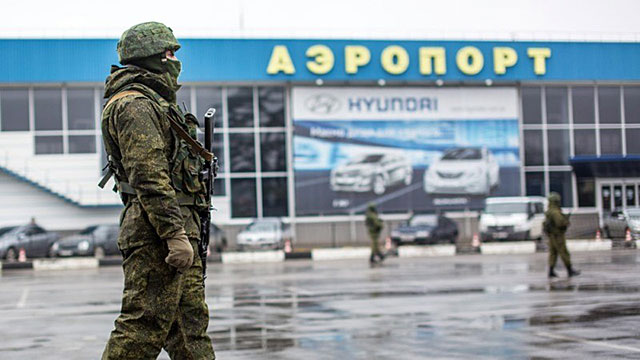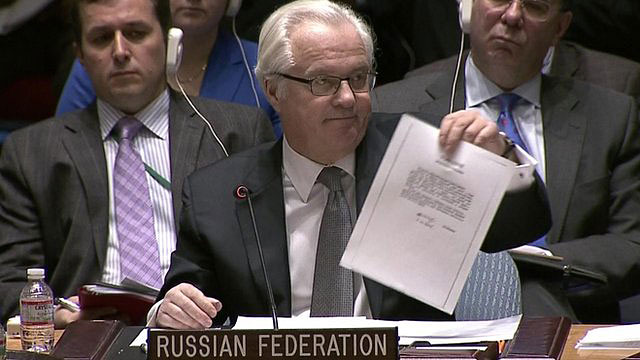The political and military crisis in Ukraine, instigated by the Kremlin, remains the principal concern for the international community. Donald N. Jensen, Resident Fellow at the Center for Transatlantic Relations at the Johns Hopkins School of Advanced International Studies, analyzes the possible risks—both for Ukraine and for Vladimir Putin’s regime in Russia.

Simferopol's Belbek Airport in Crimea guarded by "unidentified" military personnel.
In response to the political upheaval that resulted in the removal of the corrupt, thuggish Ukrainian president, Viktor Yanukovych, and the installation of a pro-Western government, on February 27, up to 120 heavily armed and unknown gunmen, reportedly from Sevastopol, occupied and raised the Russian flag over the regional legislature and government buildings in Simferopol. Shortly afterwards, Russian military forces consolidated their hold on Ukraine’s Crimean peninsula on March 2, a day after gaining control of the region’s main airports and following the Russian Duma’s approval of Vladimir Putin’s request to deploy troops. As tensions increased, the Ukrainian government called for international help, and U.S. and EU leaders warned that they would impose penalties on the Kremlin.
Ukraine is of critical strategic importance for the Kremlin, its plans for a Eurasian Union, and the future of the Putin regime itself. Putin thus sees the European Union’s attempt to sign an association agreement with Ukraine as little more palatable an option than NATO’s attempt to place Georgia on the path to admittance in 2008. The Kremlin perceives a free-market, democratic Ukraine, especially one integrated into Western economic and security structures, as a direct threat. Moreover, in the twenty years of Ukrainian independence, many Russians have never accepted that the country is truly separate from Russia. (“Ukraine is not even a state,” Putin told George Bush in 2008. “Part of its territories [are] in Eastern Europe, but the greater part is a gift from us.”) Instead of building positive relations with its neighbor, Russia has tried to do everything it can to keep Ukraine within its sphere of influence. It regards the leadership in Kiev as either a vassal or an enemy, depending on who is in charge.
There is no doubt that the Ukrainian crisis has been created by Moscow. The Kremlin’s hand was not hidden even in the Yanukovych regime’s last days.
There have been several factors at play in the recent Ukrainian events besides the desire of most Ukrainian people that Yanukovych’s corrupt, authoritarian system be dismantled, including the country’s East-West divide, a political power struggle, an overlapping contest among business oligarchs, competition between Russia and the European Union for influence, and a struggle for national identity. But there is no doubt that the Ukrainian crisis has been created and fed by Moscow. The Kremlin’s hand was not hidden even in the regime’s last days. An unidentified Russian official told the Financial Times on February 20, days before Yanukovych’s flight, that Russia was willing to fight a war over the Crimea if Ukraine started to disintegrate. Kremlin political strategist Vladislav Surkov was repeatedly seen by the press lurking in various places in Ukraine and meeting with Crimean leaders. The Kremlin first planned to send hard-liner Dmitri Rogozin to Kiev, presumably to strengthen the wavering Yanukovych, before cutting its losses and replacing Rogozin with the more moderate Vladimir Lukin. Finally, documents released by a Ukrainian legislator showed that Russian advisors played a key role in planning a crackdown, which Yanukovych’s special forces botched and the former president then canceled.
Putin was surprised and angered not only by Yanukovych’s half-hearted crackdown, but also by the demise of his regime, according to press reports. After Lukin’s negotiations with Yanukovych and three EU foreign ministers unexpectedly turned into talks over Yanukovych’s delayed surrender, Lukin returned to Moscow without signing any deal. Even more surprising to the Kremlin was the Maidan protestors’ rejection of the terms. The deal was dead in a few hours, and Yanukovych sought refuge outside Kiev. After initial signs that the Kremlin might work with the new order in Kiev—Foreign Minister Lavrov told the press on February 25 that Russia would keep out of Ukrainian affairs—the Kremlin took a tougher line almost immediately after a Security Council meeting that same day: Ukraines February Revolution, Russian officials declared, was a coup engineered by Ukrainian radicals with the assistance of Europe and the United States. Yanukovych thus was still the legitimate president, the Kremlin repeated unconvincingly (notably, the Kremlin propaganda machine made no reference to the fact that the Ukrainian president had been removed by a parliamentary vote).

Russia's UN Ambassador Vitaly Churkin demonstrates Viktor Yanukovych's letter inviting Russian troops into Ukraine.
Broader Russian incursions into other areas of Ukraine could occur at any time, and the standoff could quickly spiral out of control. But the Russian forces’ mere presence in the Crimea is a serious blow to the legitimacy of the new government in Kiev. (Many Russian provocations in recent days—Russian soldiers spitting on Ukrainian troops, for example—have been designed to insult Ukrainian dignity.) These invasions also could increase separatist pressure elsewhere and might provoke a Ukrainian response that would serve as a pretext for Russia to expand its military activity. After the collapse of his Yanukovych strategy, Putin no doubt realizes, moreover, that he needs to be tough to avoid accusations at home that he “lost Ukraine.”
Putin’s move into the Crimea is just one part of a larger plan to marginalize or remove the new Ukrainian government by intimidation, propaganda, and deception. He wants to reverse the Ukrainian revolution that ousted Yanukovych and keep the industrialized, ethnic Russian areas of southern and eastern Ukraine within the zone of Russia’s “privileged” interests—and perhaps even within the future Eurasian Union. Even if the Kremlin decides to consolidate its military gains in the Crimea for now, it can nevertheless exert pressure on other fronts to pursue its objectives:
- It can deny economic assistance to the new government in Kiev and revoke the reduction in gas prices to force an economic collapse.
- By recognizing the disgraced Yanukovych as the legitimate president of Ukraine, it has a political vehicle to engineer regional coups in ethnic Russian areas and install sympathetic governments that would recognize the ousted president’s “authority.”
- In insisting on the full implementation of the February 21 agreement between Yanukovych and the three EU foreign ministers, Moscow can try to impose a new negotiated power-sharing arrangement that would expand the autonomy of the ethnic Russian regions and legitimize the Russian military presence in the Crimea.
- Russia can exploit differences in the West about how to handle the crisis. The German government’s response to the crisis, in particular, has been milder than that of France, Britain, or the United States. Based on his experience with the Georgia crisis in 2008, Putin probably calculates that any Western response now is likely to be temporary, confused, and weak.
Although the Kremlin appears for now to be in the driver’s seat, it will face significant risks both at home and abroad should tensions continue or overt hostilities break out. On March 3, the first working day after Russia invaded the Crimea, stocks on the Moscow Stock Exchange, including those of Gazprom and Sberbank, pillars of the Russian state and cash cows for the Russian leadership, dropped by more than 10 percent. The Russian government also used $10 billion from its reserves to prop up the ruble, which reached an all-time low against the dollar and the euro.
Inside Ukraine, there are already worries about the Kremlin, including the following:
- Although there have been antigovernment protests in eastern and southern Ukraine, the idea of splitting the country appears to have little popular support. There is as yet no organized pro-Moscow political force in the region; nor is there any sign of armed units being created, as happened in previous wars in Nagorno-Karabakh and Croatia.
- It is unclear whether there is sizeable grassroots support, especially among the region’s Tatar population, for the proposal that the Crimea rejoin Russia.
- A long, bloody civil war in southern and eastern Ukraine likely would drag in Russia, draining the faltering Russian economy and threatening the Putin regime itself, which, as Yanukovych’s demise has showed, is not viable in the long term.
In just a few days Putin has strengthened Ukraine’s sense of national identity far more than could years of bearing up under the unlamented Yanukovych’s misrule.
The reaction among Russia’s neighbors should also be of concern to the Kremlin. A Kyrgyz editorial in AKIpress on February 24 stated that the recent events are “burying the Eurasian empire.” Without Ukraine, it argued, Putin’s “sovietization of the post-Soviet space” could not occur. Instability could spread outside Ukraine, especially into Moscow, as Russia tried to hold on to eastern Ukraine or the Crimea. In the long run, opposition movements in other post-Soviet countries might try to repeat the Maidan events.
How the crisis plays out in the coming weeks depends not only on Putin but also on factors beyond his control, including the success of the new government in Kiev in consolidating its authority and establishing its legitimacy; Western resolve; and the strength of misgivings about Putin’s course on the part of the Russian elite, who will face massive business losses if war breaks out, as well as potential financial sanctions and travel bans from the West. There is also the danger that the Kremlin believes its own propaganda. But one outcome that is already apparent is that Putin’s “thrust to the south,” to use the words of long-time nationalist agitator Vladimir Zhirinovsky, in just a few days has strengthened Ukraine’s sense of national identity—in distinction to that of its bullying neighbor—far more than could years of bearing up under the unlamented Yanukovych’s misrule.

